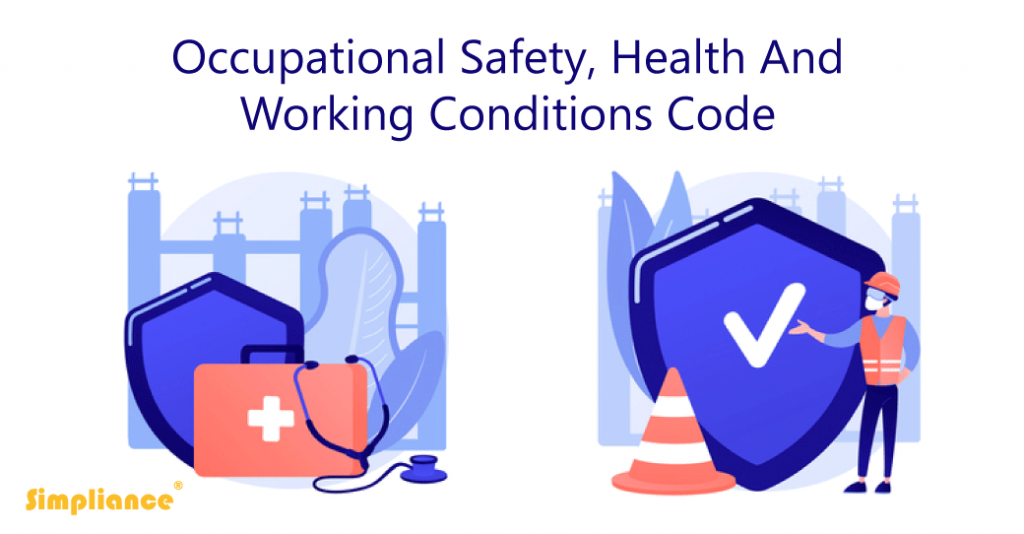
Introduction
The OSHWC Code was passed by Parliament with the intention of subsuming the following Central laws:-
- The Factories Act, 1948
- The Contract Labour (Regulation and Abolition) Act, 1970
- The Mines Act, 1952
- The Dock Workers (Safety, Health and Welfare) Act, 1986
- The Building & Other Construction Workers (Regulation of Employment and Conditions of Service) Act, 1979
- The Plantations Labour Act, 1951
- The Inter-State Migrant Workmen (Regulation of Employment and Conditions of Service) Act, 1979
- The Working Journalist and other Newspaper Employees (Conditions of Service and Miscellaneous Provisions) Act, 1955
- The Working Journalist (Fixation of rates of wages) Act, 1961
- The Cine Workers and Cinema Theatre Workers Act, 1961
- The Motor Transport Workers Act, 1961
- The Sales Promotion Employees (Conditions of Service) Act, 1976
- The Beedi and Cigar Workers (Conditions of Employment) Act, 1966
According to Section-1(2) of the Code, it must be brought into force by a notification issued by the Central Government.
Registration of Establishments
While the form and particulars pertaining to the procedure for establishments have not been spelt out clearly, the substantive provisions under Section-3(1) provide different processes for:-
- Establishments that come into existence after the commencement of the Code
- Establishments to whom the Code shall be applicable within 60 days of it coming into force
Every application made under sub-section (1) must be submitted to the registering officer, who shall register the establishment and issue a certificate of registration electronically to the employer. The proviso to sub-section (3) makes it clear that if a registering officer fails to entertain the application of/ register an establishment in the period prescribed under the Code, then the establishment shall be deemed registered.
Section-3(4) requires the employer to report any change in ownership/management or other particulars mentioned in the application submitted for registration. The same can be done electronically and must be completed within 30 days of the aforementioned change taking place. The certificate of registration will be amended by the registering authority electronically.
Section-3(5) requires an employer to inform the registering officer of closure of establishment within 30 days of the same and certify payment of all dues to the workers employed therein. Most importantly sub-section (8) provides that if an establishment has been registered under any other Central Labour law or any other law notified by the Central Government which applies to it, the establishment is then deemed registered under the OSHWC Code.
Section-5 of the Code also requires employers of establishments that are factories, mines, employing contract labour or carrying out building or other construction work, to provide a notice of commencement of operations. Similarly, they are required to intimate the prescribed authority of cessation of operations as well.
Notice Requirements
The Code imposes the liability to notify the employer in multiple places, they are as follows:-
Section-10 under the Code requires an employer to provide notice of an accident that causes death or which causes bodily injury that leads to a person being impaired such that he/she cannot work for 48 hours or more. In cases where death occurs, the appropriate authority/Chief Inspector-cum-Facilitator shall make an inquiry into the same within 2 months from the receipt of notice.
Section-11 under the Code relates to notice requirement in cases of dangerous occurrences on the premises of an establishment. Whereas Section-12 relates to the employer’s liability to provide notice in case a worker in the establishment contracts a disease specified in the Third Schedule under the Code which contains a list of notifiable diseases.
Section-31 under the Code requires an employer to clearly display accurate notice containing the periods of work for every working day in a week. The Form for the same will be provided under the Rules supplementing the Act, however, for the employer to introduce any proposed change in the system of work in the establishment that requires by consequence a change in the notice of periods of work, then the same must be intimated to the Inspector-cum-Facilitator before the change is made. If the change has been made with the previous sanction of the Inspector-cum-Facilitator, then no change can be made until one week has passed since the previous change.
Welfare Facilities, Working Hours and Annual Leave
Chapter-VI provides for welfare facilities that need to be maintained in an establishment under Section-24, these include but are not limited to, the following:-
- Adequate and separate washing facilities for men and women
- Facilities for bathing and locker-rooms for men, women and transgender employees separately
- Space to store clothes that are not used during the hours of work
- Seating arrangements for employees obliged to work in a standing position
- Canteen in an establishment for employees thereof, wherein 100 or more workers including contract labourers are ordinarily employed
- In case of mines a medical examination must be provided to persons who are to be employed and who are in employment, both before their employment as well as at specific intervals during the same
- Adequate first aid-boxes readily accessible during all working hours
The Government may add any other welfare measures it deems fit to improve the standard of life of the employees.
Chapter-VII relates to working conditions relating to hours of work, weekly rest day and annual leave with wages amongst other topics. Section-25 relates to daily and weekly working hours as well as leave, sub-section (1) states that no worker shall be required or allowed to work for more than:
a) 8 hours in a day; and
b) The period of work in the eight hours shall be so fixed so as to not exceed such hours with intervals and spread overs, as may be notified by the appropriate Government
To this general requirement under Section-25(1) there are specific provisions provided under the subsequent subsections that provide for conditions applicable to workers employed in mines, motor transport workers, working journalists, sales promotion employees and adolescent workers.
Section-26 of the Code relates to weekly and compensatory holidays and states that no worker shall be allowed to work in an establishment for more than 6 days in any one week. A proviso is made with regards to motor transport undertakings and compensatory holidays in case of exemption provided to any establishment.
Section-27 makes provisions for wages to be paid for overtime work, it stipulates that there shall be wages paid at twice the rate of wages in respect of overtime work. This is applicable when a worker works in an establishment or class thereof for more than such hours of day as may be prescribed. The period of overtime work shall be calculated on a daily basis or weekly basis, whichever is more favourable to the worker.
Section-28 of the Act relates to night shift regulations that apply to workers whose shift extends beyond midnight, a weekly holiday for a full day in the context of such workers means a period of 24 hours beginning when the worker’s shift ends. The following day shall be deemed to be the period of 24 hours beginning when the shift ends, and the hours worked after midnight shall be included in the previous day.
Section-32 of the Code provides for annual leave with wages. It states that every worker employed in an establishment shall be entitled for leave in a calendar year with wages, subject to the following conditions:-
- The employee has worked 180 days or more in a calendar year
- The employee shall be entitled to one-day leave for every 20 days of work (in case of adolescent worker and worker employed in mines below ground, every 15 days)
- Any period of layoff, maternity leave or annual leave availed shall be counted for calculating the period of 180 days as mentioned above but cannot be computed for earning leave
- Any holidays that fall between the leave availed by a worker shall be excluded from period of leave so availed
- In cases where a worker’s services have commenced otherwise than on the first day of January, the worker shall be entitled to leave with wages at the rate specified in clause (ii) if he has worked for one-fourth of the total number of days in the remaining part of the calendar year
Provisions relating to leave encashment at the time of discharge/dismissal, death or superannuation during the course of employment are also laid out under Section-32. Most notably, it also provides for carry forward of leaves in case a worker does not avail the whole of the leave allowed to him in any one calendar year. However, the total number of leave days that may be carried forward cannot exceed 30 days and any leave with wages that have been refused can be carried forward without limit.
Registers, Records and Returns
An employer is required to maintain register in the form prescribed by the Central Government either electronically or otherwise, that includes the following particulars:-
(i) Work performed by the employees
(ii) Number of hours of work that constitute normal working hours in a day
(iii) Weekly scheduled rest day
(iv) Wages paid and receipts provided thereof
(v) Leave, leave with wages, overtime work, attendance, and dangerous occurrences
(vi) Employment of adolescents
It also requires employers to issue wage slips and file electronic returns as may be prescribed under the Rules supplementing the Code.
Third Party Audit and Certification
This is a new aspect introduced under Section-37 of the OSHWC Code which allows the appropriate Government to formulate a scheme to allow experts possessing such qualifications and experience as may be prescribed to conduct third party audit and certification in a randomized manner. They may also perform any duties specified as a part of such a scheme and submit reports to the concerned employer and Inspector-cum-Facilitator.
Contract Labour & Inter-State Migrant Workers
Section-45 specifies the threshold for applicability for Part-I under Chapter-XI, which contains special provisions for contract labour and inter-state migrant workers. It states that Part-I is applicable to:-
- Every establishment in which fifty or more contract labour are employed or were employed on any day of the preceding 12 months through contract
- Every manpower supply contractor who has employed on any day of the preceding 12 months fifty or more contract labour
Section-47 provides for a scheme of licensing of contractors and stipulates that no contractor can supply, engage, or undertake work through contract labour except under a licence issued to him under Section-119. The same is a common licence in respect of factory, industrial premises for beedi and cigar work as well as for engaging contract workers.
In case a contractor cannot fulfil the criteria under Section-119 he may apply for a “work specific licence” that is electronically renewable and is applicable only for the supply/engagement of contract labour for the particular work order specified in the license. Section-48 lays down the procedure for the issuance as well as renewal of a licence, it states that an issued licence shall be valid for five years and thus the yearly renewal system under the current Contract Labour (Regulation and Abolition) Act, 1971 is done away with.
Part-II under Chapter-XI applies to Inter-State Migrant workers and Section-59 clearly states that the criteria for application is every establishment in which ten or more Inter-State migrant workers are/have been employed on any day of the preceding 12 months. It is pertinent to note here that the definition of contract labour under the OSHWC Code includes Inter-State migrant workers who have thus acquired parity with contract labourers as far as statutory rights and benefits are concerned.
Conclusion
While the above measures brought in by the Government in the OSHWC Code are a big step towards simplifying India’s complex regulatory framework, there still remain several grey areas that need to be addressed. One such area is the conflict between State shops and establishments laws and the labour Codes, there needs to be a way to reconcile provisions that are conflicting or repugnant to the framework under the Codes.
Another major area for concern is the sheer amount of delegated legislation in the form of rules, notifications, and orders that the Codes require as part of their framework. Keeping track of the same will be essential for HR and Compliance experts to ensure that their organizations are up to date with the latest changes in labour laws.
How do you think the above concerns need to be addressed? Is the scope given to delegated legislation excessive under the OSHWC Code?
Drop your thoughts in the comments below.
Follow Simpliance for more in-depth content on the labour Code and its related rules, notifications and advisories.
| Disclaimer: This blog is meant for informational purposes and discussion only. It contains only general information about legal matters. The information provided is not legal advice and should not be acted upon without seeking proper legal advice from a practicing attorney. Simpliance makes no representations or warranties in relation to the information on this article. |



Being a 3rd party contractual employees we always been criticized for taking leave, stating that we are not authorized for any leave. Even our contract says that if we take leave for one day, two days pay will be curtailed from our salary. We are under DC rates of UT Chandigarh, feels humiliated as far as leave is concerned. please clarify or show us the exact leave rules for the third party contractual employees.
for education